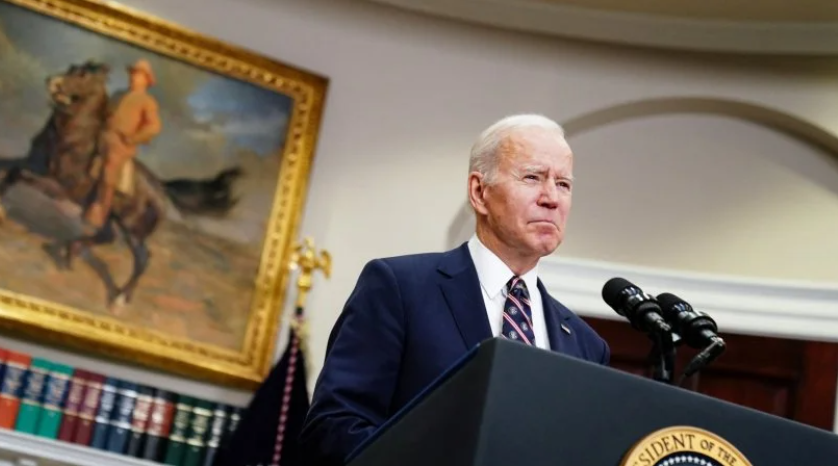За останній час під впливом новин про політичну ситуацію в Україні та рекомендацій Державного департаменту США щодо виїзду громадян цієї країни, декілька америнських легіонерів піддались паніці, та незважаючи на контракті зобов’язання перед клубами, залишили нашу країну.
Для заспокоєння ситуації до клубів, гравців та агентів звернувся президент Федерації баскетболу України Михайло Бродський з листом, який роз’яснює становище у країні, а згодом Михайло Бродскький ініціював звернення до ФІБА у зв’язку з від’їздом гравців.
Втім, як виявилось, Рада національної безпеки США разом і розвідка навмисно надавали адміністрації президента Джо Байдена дані про тривожні сценарії загрози вторгнення РФ в Україну, щоб зірвати плани та стримати дії Росії, повідомило CNN із посиланням на представників адміністрації Білого дому.
Такі дії обережно координувалися і, за словами співрозмовників, є ознаки, що “ця стратегія працює”.
Один із високопосадовців адміністрації вважає, що президента Росії Володимира Путіна застали зненацька, а перехоплені дані розвідників змусили російських військових та представників розвідки РФ нарікати на викриття їхніх планів, пише CNN.
Деякі близькі до розвідки джерела CNN були здивовані кількістю інформації, яку публічно оприлюднили, зокрема й про наміри РФ сфабрикувати привід для військової операції в Україні, використавши відео. Водночас один із представників розвідки запевнив, що там дотримуються стандарнтих процедур розсекречення, що існують для захисту джерел і методів.
Доводимо до вашої уваги оригінал новини на CNN.
“For months, the Biden administration has fueled alarming headlines and surprised Washington with a remarkable drumbeat of official disclosures of previously classified intelligence revealing Russian moves as Moscow masses troops on the Ukrainian border.
Administration officials tell CNN the disclosures have been carefully coordinated among the National Security Council, the intelligence community and other national security agencies in an effort to disrupt Russian planning, blunt the effectiveness of any “false flag” operations and, ultimately, deter military action.
And there are signs the strategy is working, US officials say. The Biden administration believes Russian President Vladimir Putin has been caught off guard by some of the releases, according to one senior US official, and intelligence intercepts have picked up Russian military and intelligence officials grumbling about the exposure of their plans, CNN has previously reported.
“The hope is that the Russians are surprised about the allied knowledge of these things, and that they have an internal reaction,” a senior Western intelligence official told CNN. “Usually, what you’d expect to see would be the Russians wondering if they have a mole.”
“That’s useful to make them doubt themselves. It’s useful to make them question whether they can actually execute some of these plans and still have secrecy and surprise,” this person continued. “Sometimes, if you put enough doubt in the system, they may actually remove some competent people who they suspect of being spies who, in fact, aren’t spies at all.”
Although the United States has downgraded and publicized classified information in the past in service of other foreign-policy goals — sometimes effectively; sometimes, as in the run-up to the Iraq War, disastrously — the sheer volume of disclosures makes Biden’s approach to the slow-rolling crisis notable.
Clashes with the media
The strategy has also led to clashes with the US media over the administration’s unwillingness to show proof of its claims. The disclosures have largely come in the form of statements from agency spokesmen and officials have provided little by way of evidence — in effect, asking reporters to report the material without confirmation. (Other media reports on the crisis, of course, have come from conventional reporting and unauthorized leaks.)
“If you doubt the credibility of the US government, of the British government, of other governments and want to, you know, find solace in information that the Russians are putting out, that is for you to do,” State Department spokesman Ned Price said when challenged last week. He subsequently called the reporter in question to apologize.
Last week, spokespeople for multiple US agencies said the US had intelligence showing Russia planned to release a scripted video showing staged attacks by Ukrainian forces to drum up a pretext for military action. In January, the US said it had credible information indicating Russia had prepositioned a group of operatives to conduct a separate false-flag operation in eastern Ukraine. And in December, the White House released a declassified document that said Russia was planning an offensive in early 2022 involving up to 175,000 troops. Officials have also been remarkably detailed in public about the number of Russian troops they see amassed on the border — intelligence that has been backed up by commercial satellite imagery released by private companies.
“We’re not instrumentalizing the press. What we’re doing is conducting a strategic communications campaign,” the Western intelligence official said. “Keep in mind that there are many potential audiences of these disclosures, whether they’re made from the podium or they’re made in a background briefing or in other formats. I would judge that the State Department was probably also trying to tell the American people that ‘This is the nature of this crisis. This is what we see.’ ”
The tactic has some high-profile Cold War precedents. In 1962, President John F. Kennedy’s administration released photographs of Soviet ballistic missiles positioned in Cuba amid the escalating crisis there, in part to convinc a skeptical press corps in the US and the UK.
In 2022, the goal is more operational: It’s an effort to deny Russia the same element of surprise that it took advantage of in 2014, when it annexed Crimea. Many of the same US officials in government now had front row seats to the decision-making in 2014 and are “absolutely” responding to lessons learned from that experience, Western diplomats told CNN.
In 2014, Western officials were caught flat-footed by Russia’s denials that it was sending unmarked troops into the peninsula ahead of the actual assault, according to one Western diplomat. Officials told reporters on background that they were skeptical of the “little green men” on the ground, but did not go on the record to counter Russia’s denials.
The United States has long struggled to respond to Russia’s use of so-called “grayzone” warfare tactics — things like disinformation and false-flag operations — which the US military historically isn’t set up to carry out or counter. Intelligence officials have for decades debated how and when to make early disclosures of intelligence to disrupt those sorts of asymmetric tactics. Those discussions have only escalated as Putin’s Russia has capitalized on the digital age to conduct sophisticated information warfare, current and former officials say.
But the Biden administration’s strategy of repeated disclosures offers one of the first sustained examples of a relatively new and untested doctrine.
“The new doctrine is the potential to use intelligence as an information operations weapon,” said former Director of National Intelligence James Clapper, who noted that the Obama administration had made similar disclosures after the Russian invasion of Ukraine in 2014.
Case-by-case basis
The releases have also drawn attention because much of the information could not have been learned from satellite images alone — which are often duplicated in public channels — instead signaling clear US access to Russian military and intelligence channels.
Satellite images offer comparatively limited insights, current and former intelligence officials note. It’s impossible to glean Putin’s intent from mere tank formations, which can be used as decoys. US officials are aware that Russian military doctrine explicitly embraces deception — a concept known in Russian as “maskirovka,” or “masking.”
But the intelligence releases on alleged false-flag operations are also the riskiest to the United States, former officials say.
“Obviously, the downsides to doing stuff like this is, ‘Is whatever source we got that from going to dry up on us?’ ” Clapper said. “That’s always the risk-gain assessment that you have to do.”
Another source familiar with the intelligence admitted that he has been “personally a little surprised at how much has been publicly revealed, though I can appreciate the balance between revealing Russian schemes and burning sensitive sources and methods.”
Current US officials say the decision to downgrade any one piece of information has gone through normal processes, led by the Office of the Director of National Intelligence, and that no disclosure has been made that could expose the means by which the United States gathered the information in the first place.
“The intelligence community used its standard declassification procedures, which are in place to protect sources and methods,” said a US intelligence official.
Meanwhile, an extraordinary amount of the Russian buildup has played out in public, freeing the administration to publicly discuss the kind of hard intelligence about troop numbers and force positioning that in past confrontations would have been classified. As commercial satellites have proliferated and advanced in recent years, high-resolution photos of Russian troop and tank formations that would once have been the sole purview of government satellites are now made public by private companies like Maxar.
The strategy has also been part and parcel of a larger effort by the Biden administration to share intelligence to keep its partners and allies on the same page about the nature of the threat.
“I have never seen it work like this. It is a whole-of-government approach. US officials are thinking about who should we bring into the conversation in a very proactive way,” said a State Department official familiar with the process. “And a lot of these conversations about intelligence sharing are happening because certain countries just do not believe what we are saying is true.”
Publicly, Russia has responded by flatly denying the American reports, characterizing them as propaganda and hysteria.
“So far, all these statements have been unfounded and have not been confirmed by anything,” Dmitry Peskov, the spokesman for Putin, said after a recent disclosure.
Reporters, often explicitly recalling credulous reporting of Bush administration claims of intelligence in the run-up to the Iraq War, have pressed officials to provide evidence backing up the releases. In 2003, much of the intelligence deliberately released to reporters and the global community, alleging evidence that Saddam Hussein was reconstituting a nuclear weapons program, turned out to be grievously wrong — in part thanks to the US reliance on a single, unreliable source.
A National Security Council spokesman said Tuesday that the administration cannot make any of the underlying information public “without compromising intelligence sources and methods,” adding that “there is value to the public in exposing these operations and to dissuading Russia from pursuing them.”
Still, Biden’s disclosures have broadly earned positive reviews as a judicious and effective use of intelligence, according to sources across the US government who are familiar with the underlying information.
“I think it’s a good thing to do, because by diming out the Russians, particularly if you can do it preemptively, then you may prevent that very thing from happening — and it would appear, at least so far, that may be the case,” Clapper said”.





Навмисно, шоб прслабити українську Суперлигу.
Переведите на русский или украинский